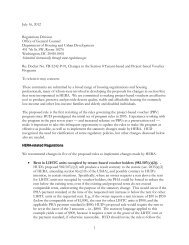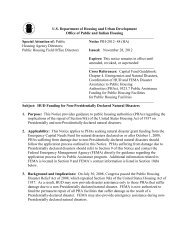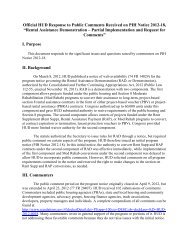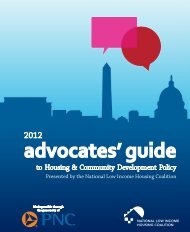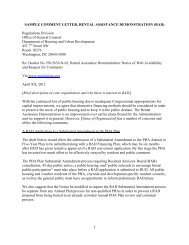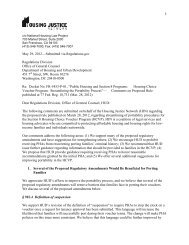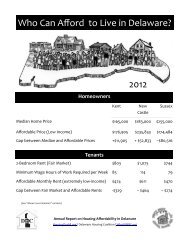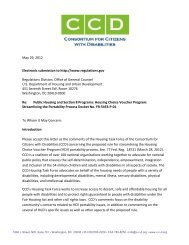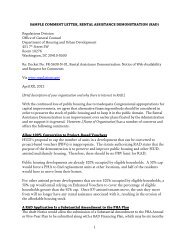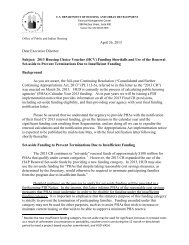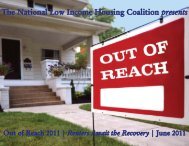Dark Before the Storm (.pdf, 131 KB) - National Low Income Housing ...
Dark Before the Storm (.pdf, 131 KB) - National Low Income Housing ...
Dark Before the Storm (.pdf, 131 KB) - National Low Income Housing ...
You also want an ePaper? Increase the reach of your titles
YUMPU automatically turns print PDFs into web optimized ePapers that Google loves.
Conclusion<br />
This assessment of <strong>the</strong> 2005-07 CHAS data reveals that even before <strong>the</strong> start of <strong>the</strong> housing crisis and <strong>the</strong> current recession,<br />
<strong>the</strong>re were significant shortages of standard rental units that were affordable and available to low income households in<br />
every state and that nationwide, three out of every four ELI and VLI households were spending more than half of <strong>the</strong>ir<br />
income on housing and utility costs.<br />
Since 2007, <strong>the</strong> homeownership rate has fallen due to <strong>the</strong> foreclosure crisis and <strong>the</strong> instability of <strong>the</strong> housing market. 13<br />
Many households are returning to <strong>the</strong> rental market. Fur<strong>the</strong>rmore, <strong>the</strong> unemployment rate has soared and incomes have<br />
declined dramatically. 14 These economic trends suggest that more people have become low income renters and <strong>the</strong> demand<br />
for affordable rental housing will continue to rise. There is, however, no indication that <strong>the</strong> supply of long term affordable<br />
rental housing will meet this rising demand. In fact, in an analysis of <strong>the</strong> 2007 and 2008 American Community Survey<br />
(ACS) data, NLIHC found that <strong>the</strong> affordability gap worsened for <strong>the</strong> lowest income renters in <strong>the</strong>se years 15 and <strong>the</strong> recent<br />
release of <strong>the</strong> 2009 ACS data reveals that <strong>the</strong> proportion of renters facing unaffordable housing costs increased from 2008<br />
to 2009. 16 Fur<strong>the</strong>r data shows that rental vacancy rates are at historic highs, but it does not appear that <strong>the</strong>se vacant units<br />
are affordable to ELI and VLI households. Instead <strong>the</strong>se vacancies are part of high-rent developments that were overbuilt<br />
in <strong>the</strong> boom years and units that were previously for-sale, but are now for-rent. 17 All <strong>the</strong> information presented here shows<br />
worsening housing problems for low income renters from 2000 to 2005-07, and it is very likely that <strong>the</strong> situation has<br />
deteriorated fur<strong>the</strong>r since 2007.<br />
During <strong>the</strong> housing boom of <strong>the</strong> 2000s, <strong>the</strong>re was a rush to build luxury developments to rent and own and in general<br />
a strong emphasis on homeownership in both <strong>the</strong> single family and multifamily sectors, while <strong>the</strong>re was a simultaneous<br />
decrease in <strong>the</strong> supply of units receiving project based assistance from HUD. 18 This report shows that in <strong>the</strong> boom years<br />
<strong>the</strong>se shifts in <strong>the</strong> market and in public policy led to an increase in <strong>the</strong> proportion of renters with one or more housing<br />
problems, especially among VLI and LI renters. The recession has amplified <strong>the</strong>se conditions. While every state has different<br />
needs, broadly defined <strong>the</strong>re is a significant and growing need across <strong>the</strong> country for more affordable housing resources.<br />
13 U.S. Census Bureau. <strong>Housing</strong> vacancies and homeownership (CPS/HVS) second quarter 2009, historic tables, table 8. Washington, DC:<br />
Author.<br />
14 Bureau of Labor Statistics. (2010, October). The employment situation: September 2010. Washington, DC: U.S. Department of Labor.<br />
15 Pelletiere, D. (2009, November). Preliminary assessment of American Community Survey data shows housing affordability gap worsened<br />
for lowest income households from 2007 to 2008. Washington, DC: <strong>National</strong> <strong>Low</strong> <strong>Income</strong> <strong>Housing</strong> Coalition.<br />
16 U.S. Census Bureau. American Community Survey 2008 and 2009, table B25070. Washington, DC: Author.<br />
17 Collinson, R. & Winter, B. (2010, January). U.S. rental housing characteristics: supply, vacancy, and affordability. HUD PD&R Working<br />
Paper 10-01. Washington, DC: U.S. Department of <strong>Housing</strong> and Urban Development.<br />
18 NLIHC tabulations of HUD’s “A Picture of Subsidized Households” from 2000 and 2008.<br />
11



